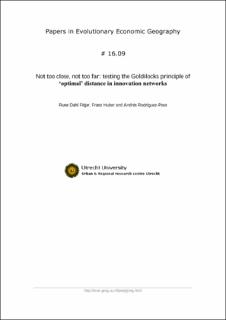| dc.contributor.author | Fitjar, Rune Dahl | |
| dc.contributor.author | Huber, Franz | |
| dc.contributor.author | Rodríguez-Pose, Andrés | |
| dc.date.accessioned | 2021-11-09T14:31:06Z | |
| dc.date.available | 2021-11-09T14:31:06Z | |
| dc.date.created | 2016-10-27T14:32:38Z | |
| dc.date.issued | 2016 | |
| dc.identifier.citation | Fitjar, R.D., Huber, F., Rodríguez-Pose, A. (2016) Not too close, not too far: testing the Goldilocks principle of ‘optimal’ distance in innovation networks. Industry and Innovation, 23 (6), 465-487. | en_US |
| dc.identifier.issn | 1366-2716 | |
| dc.identifier.uri | https://hdl.handle.net/11250/2828727 | |
| dc.description | This is an Accepted Manuscript version of the following article, accepted for publication in Industry and Innovation. Rune Dahl Fitjar, Franz Huber & Andrés Rodríguez-Pose (2016) Not too close, not too far: testing the Goldilocks principle of ‘optimal’ distance in innovation networks, Industry and Innovation, 23:6, 465-487, DOI: 10.1080/13662716.2016.1184562. It is deposited under the terms of the Creative Commons Attribution-NonCommercial License (http://creativecommons.org/licenses/by-nc/4.0/), which permits non-commercial re-use, distribution, and reproduction in any medium, provided the original work is properly cited. | en_US |
| dc.description.abstract | This paper analyses how the formation of collaboration networks affects firm-level innovation by applying the ‘Goldilocks principle’. The ‘Goldilocks principle’ of optimal distance in innovation networks postulates that the best firm-level innovation results are achieved when the partners involved in the network are located at the ‘right’ distance, i.e. ‘not too close and not too far’ from one another, across non-geographical proximity dimensions. This principle is tested on a survey of 542 Norwegian firms conducted in 2013, containing information about firm-level innovation activities and key innovation partners. The results of the ordinal logit regression analysis substantiate the Goldilocks principle, as the most innovative firms are found among those that collaborate with partners at medium levels of proximity for all non-geographical dimensions. The analysis also underscores the importance of the presence of a substitution–innovation mechanism, with geographical distance problems being compensated by proximity in other dimensions as a driver of innovation, while there is no support for a potential overlap–innovation mechanism. | en_US |
| dc.language.iso | eng | en_US |
| dc.publisher | Informa UK Ltd. (Taylor & Francis) | en_US |
| dc.rights | Navngivelse-Ikkekommersiell 4.0 Internasjonal | * |
| dc.rights.uri | http://creativecommons.org/licenses/by-nc/4.0/deed.no | * |
| dc.subject | økonomi | en_US |
| dc.subject | innovasjon | en_US |
| dc.subject | nettverk | en_US |
| dc.title | Not too close, not too far: testing the Goldilocks principle of ‘optimal’ distance in innovation networks | en_US |
| dc.type | Peer reviewed | en_US |
| dc.type | Journal article | en_US |
| dc.description.version | acceptedVersion | en_US |
| dc.rights.holder | © 2016 Informa UK Limited, trading as Taylor & Francis Group | en_US |
| dc.subject.nsi | VDP::Samfunnsvitenskap: 200::Økonomi: 210::Bedriftsøkonomi: 213 | en_US |
| dc.source.pagenumber | 465-487 | en_US |
| dc.source.volume | 23 | en_US |
| dc.source.journal | Industry and Innovation | en_US |
| dc.source.issue | 6 | en_US |
| dc.identifier.doi | 10.1080/13662716.2016.1184562 | |
| dc.identifier.cristin | 1395147 | |
| cristin.ispublished | true | |
| cristin.fulltext | postprint | |
| cristin.qualitycode | 1 | |

